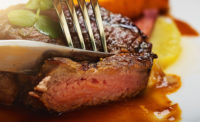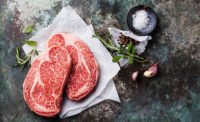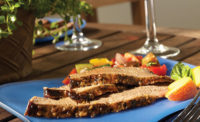Guest Commentary
The big cattle divide

The following is a meat scientist’s perspective with regard to beef cattle size — and I know I’m going to catch a lot of flak for it, but it must be said.
Beef carcasses continue to get bigger and bigger. Look at the U.S. Department of Agriculture’s (USDA) reported average beef carcass sizes. We’re adding on average of 5 pounds to each carcass. Now, when we look at beef carcasses as a whole, 5 pounds doesn’t sound like much, but when it is spread across a few years and a few primals, the impact becomes very noticeable at the meat-cutter level. We’re looking at rather large beef carcasses and we have somewhat limited options when it comes to merchandising the meat.
Option one (cue the rotten tomatoes from the beef ranchers and farmers): Make the cattle smaller. This is currently not the ideal option, but an option nonetheless. If we focus on making a more uniform raw product, we can target the “ideal” sizing when it comes to steaks and roasts at the retail counter and foodservice operations. Smaller carcasses allow for muscles that are more manageable. When the muscles are smaller in dimension, we can cut steaks and roasts thicker and allow for more “altitude” on the plate, presenting a more desirable end product. Smaller (or at the very least, not larger) cattle will solve some of the problems. A very heavily muscled beef carcass, when cutting a ribeye steak to a portion size of say, 12 ounces, will result in a steak that is very thin when compared with a smaller carcass that can produce smaller dimensions of a carcass resulting in the same steak that can be cut to a thicker dimension.
Option one sounds like a viable and achievable option to some; however, we need to look at both views. Although the idea of making the cattle smaller sounds good to the packer and processor, cattlemen (and their colleagues producing the other competing protein species) are paid on weight. Therefore, pricing signals to the livestock producer to grow the animal efficiently and big. I think we need to find another option.
Option two (unleash over-ripened fruits from the packer-processor camp): Cut the carcass differently. I distinctly recall a conference a number of years ago at which a cattle producer stood up and said, “If the muscles were getting too big on the beef carcasses, then just cut them in half.” In some ways, this overly simplified suggestion to the meat-cutting community is being done on some beef subprimals today (e.g., strip loin filet, ribeye, filet, etc.). If a carcass is muscled enough, we have the opportunity to fabricate the meat in a way that produces a more desirable portion size for the consumer while not sacrificing steak thickness. The beef industry has taken vast strides in alternative fabrication styles that better utilize individual muscles of the carcass, not only enhancing the palatability and salability of those cuts, but also minimizing the within-cut variation that old-fashioned roasts and steaks would inherently have. Many of these alternative fabrication ideas have been around for more than a decade, yet just recently have caught momentum in the meat-merchandising world. Many folks are familiar with the Flat Iron steak, but other cuts such as the Denver steak, Teres major/shoulder tender and sirloin flap are making some pretty big waves in the beef world. Fear not, cattle producer; the meat industry has heard your advice and is working on solutions.

Source: USDA National Agricultural Statistics Service
Speaking to both sides of this discussion, the meat processor’s facilities and techniques are engineered and designed to handle cattle up to a certain size. If cattle become too large, the facilities to harvest them are unable to accommodate them. On the other hand, if cattle producers don’t maintain an efficient herd that can optimize the resources they have and produce pounds on the hoof, their business is not fiscally sustainable either. These challenges are being met with some innovative incentive programs by many meat-packing companies for cattle producers who raise animals that are more ideal in size and quality for merchandising purposes. At the same time, meat processors continue to investigate ways to optimize the utilization of their facilities and equipment in unique ways to produce a cut of meat that is desirable for the consuming public.
The answers are not easy ones, and we will need to continue considering other factors with regard to size of carcasses (e.g., rail height in the plant, overhead load capacity, trailer size, carcass chilling capacity, etc ...). These are dynamic and highly variable creatures that we rely on, and it’s what makes this a fun and challenging industry. I look forward to what the future holds regarding meat production and how we can benefit both the livestock producer and the meat processor at the same time. We’re all in this together.
Go Beef! NP
Looking for a reprint of this article?
From high-res PDFs to custom plaques, order your copy today!






